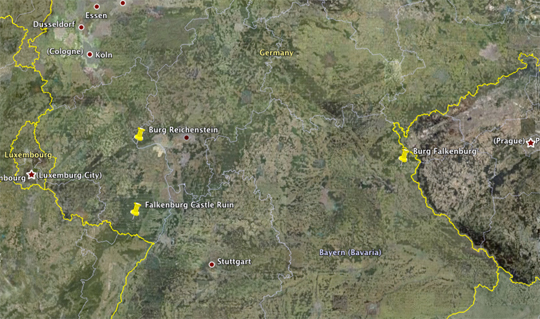Falkenburg Castles
When I was in my pre-teens I remember my grandparents telling me that we were descended form German Royalty and that our name was originally von Falkenburg. There were stories about a castle on the Rhine River that piqued a young boy's imagination. As I started to explore my roots, however, it seemed that if this is true, it was a distant connection. I tried to find the Castle Falkenburg (this was before the internet) and came up with no clues. Perhaps this story was not passed down through many generations of my family, but was a construction of my grandmother who would have liked it to be true (her mother's maiden name was van Vorhris).
In 1985 as I was planning for a trip to Germany, I came across the Castle Reichenstein which was formally named Falkenburg. My family and I visited the castle that summer. I was taken aback by the fact that the owner of the castle in the 1800's was a sea captain who had sailed up the Rhine River, to the coast and on to America. I knew that my Great Grandfather was a sea captain, so I thought that there might be a connection. But my genealogical exploration proved otherwise. The Falkenburg story I did discover was, however, as interesting as any that might have included kings, dukes, and knights.
With a little research on the internet, I have found three castles that have names related to our family name. Unfortunately, there is no documentation to connect us to any of these royal addresses.Here are the locations and descriptions of three castles in Germany associated with Falkenburg.
Schloss Reichenstein
Above the west bank of the Rhine River at the village of Trechtingshausen sits one of the oldest castles in the region. It is believed that Reichenstein dates back to the eleventh century; nearly one thousand years old! In its early days, The colorful history of Reichenstein includes its use as den of robber knights who terrorized the area. The name Falkenburg was introduced by Baron Franz Wilhelm von Barfuss who bought the castle ruin in the mid nineteenth century. The Baron discovered several nesting tower falcons in the walls and therefore named the castle Falkenburg. An extensive history Reichenstein can be found on the web. This is a combination of history lesson and travel diary. Incidentally, there is a castle hotel and restaurant at Reichenstein.
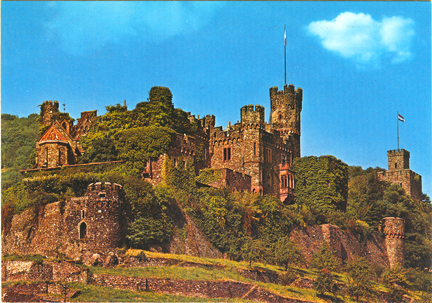
The Castle Falkenburg (Reichenstein) |
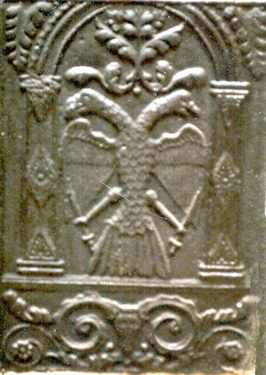
Two headed falcon on Wood Stoves in the Castle |
Falkenburg Castle near Wilgartswiesen
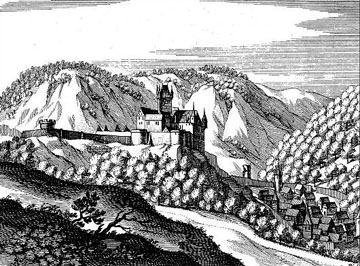 There is an interesting personal story regarding the Falkenburg Castle near Wilgartswisen. When I was studying french at the university, my teacher was a German who was from this region near the border of France and Germany. She told me that there was a castle ruin in this region that she used to play in. This is a true ruin that has not been restored.
There is an interesting personal story regarding the Falkenburg Castle near Wilgartswisen. When I was studying french at the university, my teacher was a German who was from this region near the border of France and Germany. She told me that there was a castle ruin in this region that she used to play in. This is a true ruin that has not been restored.
Falkenburg Castle near Wilgartswiesen is mentioned in one of the documents of the Archbishop Erkinbalds in 1019. This cliff named Falkenstein "is considered today as the very northern border of the Kaiserslauterer Empire. It is believed that Werner I. of Bolanden constructed the castle on this cliff in 1125. It is known that Werner I. of Bolanden was in this area from 1116 acting as a vassal to Duke Friedrich II. of Schwaben. In 1135 Sigbold of Falkenstein, one of the first Ministeriale who named himself after the castle, is mentioned in a document of the Boland family’s monastery of Hane {CAS.1}."
Beatrix von Falkenburg was born in 1253 at Falkenburg Castle in Rhineland-Palatinate (Rheinland-Pfalz). It is likely this castle at Wilgartswiesen. She was the daughter of Dirk II von Falkenburg, Count of Falkenburg. On 16 JUN 1269 Beatrix married married Richard of Cornwall (Earl of Cornwall) son of King of England John I 'Lackland' and Isabella d'Angoulême, on 16 June 1269 at Kaiserslautern {CAS.2}. Also see Cornwall {CAS.3}.
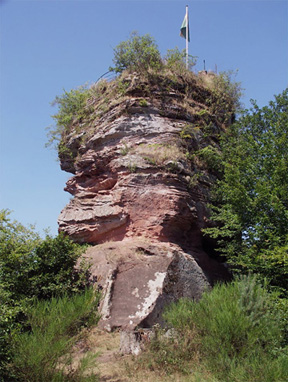
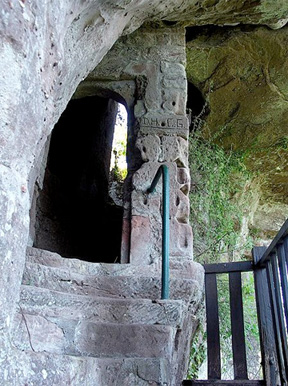
Ruins of the Castle Falkenburg near Wilgartswiesen
Burg Falkenberg
This is the quintessential German castle. It is built on a solid rock outcropping in the center of the town of Falkenberg (from Old High German, berg means mountain and burg means fortress or castle). First built in 1154, the castle sits on a granite rock and is accessed by a wooden bridge resting on stone pillars over a deep ditch. {CAS.4}
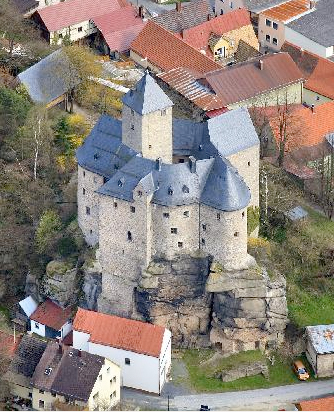 |
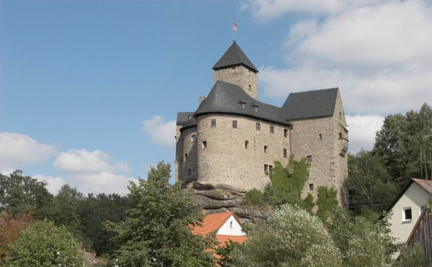 |
For more information about European castles and ruins try http://roadstoruins.com.
